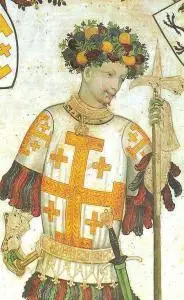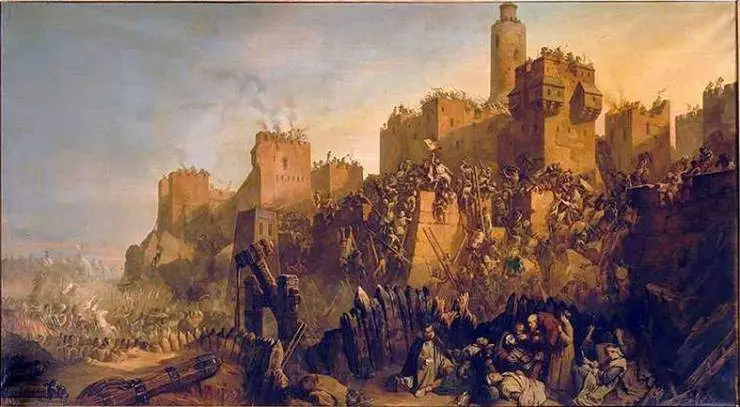
An excerpt from “Inventing the Crusades” by Dr. Thomas F. Madden.
“One can never understand the Crusades without understanding their penitential character.”
All the Crusades met the criteria of just wars. They came about in reaction attacks against Christians or their Church. The First Crusade was called in 1095 in response to the recent Turkish conquest of Christian Asia Minor, as well as the much earlier Arab conquest of the Christian-held Holy Land. The second was called in response to the Muslim conquest of Edessa in 1144. The third was called in response to the Muslim conquest of Jerusalem and most other Christian lands in the Levant in 1187.
In each case, the faithful went to war to defend Christians, to punish the attackers, and to right terrible wrongs. As Riley-Smith has written elsewhere, crusading was seen as an act of love—specifically the love of God and the love of neighbor. By pushing back Muslim aggression and restoring Eastern Christianity, the Crusaders were—at great peril to themselves—imitating the Good Samaritan. Or, as Innocent II told the Knights Templar, “You carry out in deeds the words of the gospel, ‘Greater love has no man than this, that a man lay down his life for his friends.’ ”
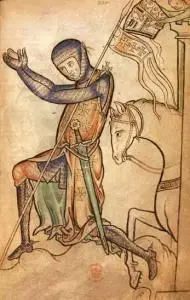
And the sacrifices were extraordinary. As Riley-Smith writes in this book and his earlier The First Crusaders, the cost of crusading was staggering. Without financial assistance, only the wealthy could afford to embark on a Crusade. Many noble families impoverished themselves by crusading.
Historians have long known that the image of the Crusader as an adventurer seeking his fortune is exactly backward. The vast majority of Crusaders returned home as soon as they had fulfilled their vow. What little booty they could acquire was more than spent on the journey itself. One is hard pressed to name a single returning Crusader who broke even, let alone made a profit on the journey. And those who returned were the lucky ones. As Riley-Smith explains, recent studies show that around one-third of knights and nobility died on crusade. The death rates for lower classes were even higher.
One can never understand the Crusades without understanding their penitential character. It was the indulgence that led thousands of men to take on a burden that would certainly cost them dearly. The secular nobility of medieval Europe was a warrior aristocracy. They made their living by the sword. We know from their wills and charters that they were deeply aware of their own sinfulness and anxious over the state of their souls. A Crusade provided a way for them to serve God and to do penance for their sins. It allowed them to use their weapons as a means of their salvation rather than of their damnation.
Of course it was difficult, but that is what penance is supposed to be. As Urban and later Crusade preachers reminded them, Christ Himself had said, “If any man would come after me, let him deny himself and take up his cross and follow me.” As one Crusade preacher wrote, “Those who take the cross deny, that is to say renounce, themselves by exposing themselves to mortal danger, leaving behind their loved ones, using up their goods, carrying their cross, so that afterward they may be carried to heaven by the cross.” The Crusader sewed a cloth cross to his garment to signify his penitential burden and his hope.
Take away penitence and the Crusades cannot be explained. Yet in the seventeenth and eighteenth centuries Protestants and then Enlightenment thinkers rejected the idea of temporal penalties due to sin—along with indulgences, purgatory, and the papacy. How then did they explain the Crusades? Why else would thousands of men march thousands of miles deep into enemy territory, if not for something precious? The first explanation was that they were fooled by the Antichrist: The Catholic Church had convinced the simple that their salvation lay in fighting its battles. Later, with the advent of liberalism, critics assumed that the Crusaders must have had economic motives. They were seeking wealth and simply used religion as a cover for their worldly desires.
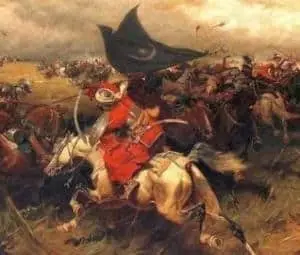
It is commonly thought—even by Muslims—that the effects and memory of that trauma have been with the Islamic world since it was first inflicted in the eleventh century. As Riley-Smith explains, however, the Muslim memory of the Crusades is of very recent vintage. Carole Hillenbrand first uncovered this fact in her groundbreaking book The Crusades: Islamic Perspectives. The truth is that medieval Muslims came to realize that the Crusades were religious but had little interest in them. When, in 1291, Muslim armies removed the last vestiges of the Crusader Kingdom from Palestine, the Crusades largely dropped out of Muslim memory.
In Europe, however, the Crusades were a well-remembered formative episode. Europeans, who had bound the Crusades to imperialism, brought the story to the Middle East during the nineteenth century and reintroduced it to the Muslims. Stripping the Crusades of their original purpose, they portrayed the Crusades as Europe’s first colonial venture—the first attempt of the West to bring civilization to the backward Muslim East.
Riley-Smith describes the profound effect that Sir Walter Scott’s novel The Talisman had on European and therefore Middle Eastern opinion of the Crusades. Crusaders such as Richard the Lionhearted were portrayed as boorish, brutal, and childish, while Muslims, particularly Saladin, were tolerant and enlightened gentlemen of the nineteenth century. With the collapse of Ottoman power and the rise of Arab nationalism at the end of the nineteenth century, Muslims bound together these two strands of Crusade narrative and created a new memory in which the Crusades were only the first part of Europe’s assault on Islam—an assault that continued through the modern imperialism of European powers. Europeans reintroduced Saladin, who had been nearly forgotten in the Middle East, and Arab nationalists then cleansed him of his Kurdish ethnicity to create a new anti-Western hero. We saw the result during the run-up to the Iraq War, when Saddam Hussein portrayed himself as a new Saladin who would expel the new Crusaders.
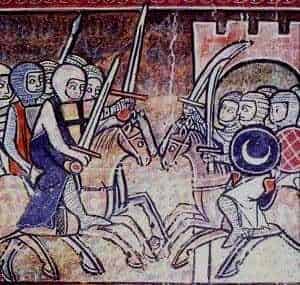
That is the Crusades’ only connection with modern Islamist terrorism. And yet, so ingrained is this notion that the Crusades began the modern European assault on Islam that many moderate Muslims still believe it. Riley-Smith recounts : “I recently refused to take part in a television series, produced by an intelligent and well-educated Egyptian woman, for whom a continuing Western crusade was an article of faith. Having less to do with historical reality than with reactions to imperialism, the nationalist and Islamist interpretations of crusade history help many people, moderates as well as extremists, to place the exploitation they believe they have suffered in a historical context and to satisfy their feelings of both superiority and humiliation.”
Read further… https://www.firstthings.com/article/2009/06/inventing-the-crusades

